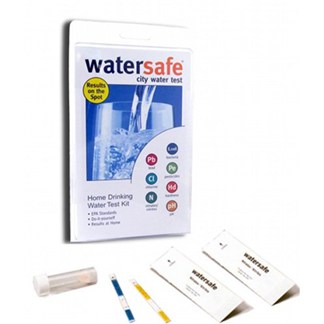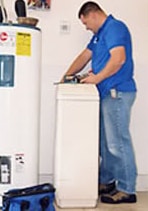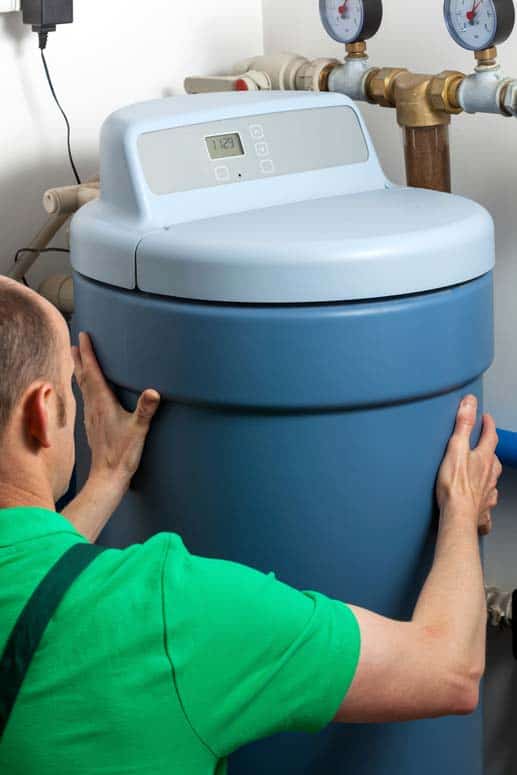How To Set Up A Water Softener
Problems with difficult water? Here's expert communication on where and how to install a h2o softener.
A water softener removes minerals from water, making a home's water kinder to bodies, hair, appliances, pipes, and more.
Hard h2o—that is, water with lots of minerals— is more a nuisance. It can stain sinks, reduce the cleaning power of detergent, cause buildup in faucets and pipes, and shorten the life of a water heater.
A water softener is the appliance that removes minerals from water. For more about water softeners and how they piece of work, please see the H2o Softeners Buying Guide. Here we'll look at where and how to install one.
To observe out whether your water is hard, you lot can purchase a water exam kit online. This will give yous a articulate idea of the amounts of minerals in your water.

Though several types of salt-gratuitous water softeners are available, a table salt-based (ion substitution) softener is the well-nigh popular. (Please see the Water Softeners Buying Guide for more information on hard water and choosing a water softener.)
Installation must attach to local plumbing codes.
Though near homeowners choose to buy and maintain their ain water softener, a feasible option is to rent one. Over the long run, renting volition cost more than buying, but information technology costs much less up front end and can salvage yous the problem of installing, maintaining, and repairing a arrangement.
Where to Install a Water Softener
If your habitation has an older water softener that you wish to supercede with a new one, plan to put the new unit in the same location. If at that place is no existing water softener in your dwelling, consider the following advice for locating your new softener.
General location. For starters, a new water softener should be located out of the way but where information technology is easy to tie it into the plumbing system—in most cases, this is in a basement, garage, or utility room, oft near the water heater. Allow enough infinite around the equipment for easy servicing.
Do not put the softener in an area where freezing might occur; this can cause permanent damage and void your warranty. If temperatures are expected to drop below 40 degrees F (4 degrees C), protect the equipment past relieving the pressure level and draining the arrangement. Besides avoid direct sunlight—and don't put the equipment outdoors.
Required hookups. A water softener will need a drain such as a floor drain or utility sink. In addition, the h2o softener volition need a nearby electrical receptacle (not controlled by a switch) that can handle the needed amperage (check the manufacturer's specifications).

Where to connect to pipes. For softening a home's entire water supply, install the softener before the water heater—this helps reduce sediment buildup in the water heater, too. In households where sodium in the drinking water may cause a health risk, it may be necessary to bypass certain faucets used for drinking h2o (such every bit the kitchen sink) or, in some cases, soften simply the hot water side of the water supply system. Be enlightened that your entire cold h2o system will lose all of the benefits of water softening if y'all practice this.

Another option is to opt for a salt-free h2o softening system (run into Salt Free H2o Softeners). Don't place the softener after (downstream from) the water heater—temperatures above 110 degrees F (43 degrees C) may damage the softener and void the warranty.
Plumbing a Water Softener
Well-nigh water softeners come up with a bypass valve that y'all must get together and attach to the unit. In addition, some local plumbing codes crave that you install shutoff valves to the pipes that lead to and from this valve so the h2o to and from the softener can be turned off easily. If your softener has such a bypass valve, adhere it to the softener, following manufacturer'south instructions.
1 Clear and sweep the area. Position the water softener where it belongs so you can easily measure for the connecting pipes. Pay attending to orientation of the unit of measurement—the INLET should be fastened to the water supply pipe and the OUTLET should go toward the water heater.
2 Shut off the business firm water supply valves. (For more nigh shutting off the water supply, run across How to Shut Off the H2o Supply.) Turn off the water heater'south h2o supply and the power to the water heater (the circuit breaker for an electric water heater or the gas valve for a gas water heater). Then open a couple of bottom-floor faucets or hose bibbs to drain the h2o from the pipes.
3 Cutting into the water supply line, using a pipe cutter, and install elbow fittings so you can run ii lines to the inlet and the outlet ports of the bypass valve. Again, pay attention to orientation: Difficult h2o from the water supply will run into the softener'southward inlet, and soft water will run out to supply the house'southward fixtures and faucets. If you lot want an outlet, such as a hose bibb, to carry difficult water, install a T fitting prior to the softener and run information technology to the outlet.
4 Cut and install the pipes that lead to the featherbed valve. Solder all the fittings and nipples before attaching them to the plastic bypass valve (the oestrus from soldering could damage the plastic). For more than, see How to Cutting & Solder Copper Pipes. If the pipes are as well large, use a reducing fitting to install pipes of the correct size. Utilise the compression fittings supplied with the softener to attach the pipes to the unit. Annotation: If y'all dwelling house's electrical arrangement relies upon the plumbing for safe grounding, you lot must install a jumper across the h2o softener installation piping to ensure proper grounding.
5 Clamp the drain hose to the softener, and run it to a drain or utility sink. The end of the hose must be at to the lowest degree 2 inches above a drain hole to prevent back siphoning of waste water, and information technology should exist deeply clamped.
Annotation that the drain hose must exist sized according to the distance of its run and its meridian in relation to the inlet. Typically, a 1/two-inch interior bore (ID) line can run upwardly to 15 feet if its belch is lower than the inlet. Yous'll need 5/8-inch ID for the same altitude if the belch is slightly higher than the inlet. For a altitude of 15 to 25 feet and/or if the drain is above the inlet, opt for 3/4-inch ID. The drain line should not be positioned more than 10 feet above the floor.
Be sure to follow the manufacturer's instructions.

+

Find a Water Softener Pro Near You lot
half-dozen Connect the brine tank's overflow tube, following manufacturer instructions for whatsoever additional associates. The overflow's discharge must be positioned lower than the overflow plumbing fixtures.
7 Set the featherbed valve to the "bypass" position and turn on the water to run through the softener for a few minutes to flush out sediment and miscarry air in the pipes. Besides open the valves to the water heater and restore its ability and/or turn the gas valve dorsum on and relight the airplane pilot if necessary (see How to Relight a Gas H2o Heater). Check for any leaks.
8 Prepare the valve to the "Backwash" position later on plugging the unit into a nearby receptacle. Then press and concord the "Regenerate" button until the valve advances to Backwash. If necessary, unplug the power to go on the command from advancing further.
9 Partially open up the inlet control on the bypass valve to slowly. The idea hither is to drain off any build up of air; once the water flows steadily to the drain and the unit stops sputtering, you tin fully open the inlet and outlet featherbed controls. Fill the tank with water and salt as directed by the manufacturer.
10 Plug in the power string once again. Press the "Regenerate" push button again and allow the unit to bike to its next stage and repeat until the "Service" setting is reached. Finally, program the controls.
The following video is quite thorough in showing you how to gather and install a water softener. Though this focuses on a Fleck 2510 model, the techniques are reasonably generic—you tin can adjust them for virtually like types of softeners.

Featured Resource: Find a Local Water Treatment Installation Pro
Telephone call for free estimates from local h2o handling pros at present:
ane-866-342-3263
Source: https://www.hometips.com/diy-how-to/water-softener-install.html

0 Response to "How To Set Up A Water Softener"
Post a Comment